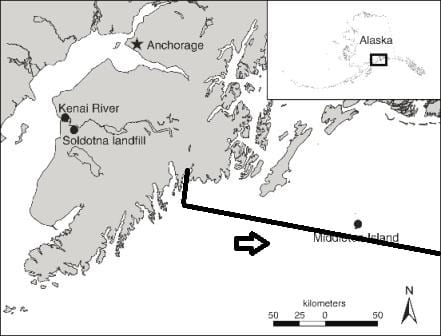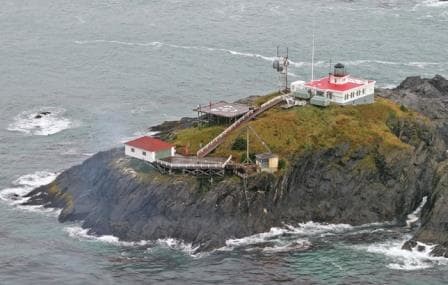The route we take today is exactly the opposite from the day before yesterday as we came from Glacier Bay, now after Seward we are going back to Glacier Bay. We are running at the sedate speed of 12 knots which will brings us to the Ranger Station at Bartlett Cove at the entrance of Glacier Bay at 07.30 hrs. tomorrow morning.
Guests sometimes complain that they do not see anything during this sea day in the Gulf but that is not correct. Yes we do not always see land; you need a very clear day to see the Fairweather Mountain Range which lies along the East Side of the Gulf. And we did indeed not see it, it was too gloomy with showers in the distance and fog patches close to land. But the wildlife can easily make up for that. You just have to be out there, be a little bit patient, and watch the sea and the sky.
And there was a lot to be seen. Apart from the regular whale sightings, we had a low flying Albatross (at least it looked like one), porpoises (maybe small dolphins) and at least 10 different species of birds. We sail no more than 12 miles from the shore line and many birds who are not deep sea birds still venture out that distance. It must be regular practice for them as we seldom have hitch-hikers on board. This is what we call birds that were blown off course or ventured too far out to sea and then land on the deck. They stay for a few hours to rest and then attempt to go back where they came from.

Middleton Island, right on our steamer track. It has a light stand to warn ships it is there and to avoid them running aground during nasty weather. Which did happen in the past.
The route, although close to the coast, is mainly in deep water 5000 to 6000 feet is the norm, except at two locations. When we pass St. Elias on the south point of Kayak Island, then we can catch the underwater out run from that island. And before we approach Resurrection Bay, in the middle of the sea, as a sort of Traffic cone, we have Middleton Island. Why do I call it a traffic one, because ships use it as a natural separation point of the routes. It is sort off the beaten track but there is still a considerable amount of traffic around. Barges to and from Seward, barges and oil tankers to and from Valdez, small boat traffic from Prince William Sound area , fishing boats all over the place and then of course us the cruise ships. For some reason we always seem to get all that traffic when we are near Middleton Island and then “the cone” helps… The Cruise ships normally stay to the south but the Fishing boats normally stay to the North.
In the old days, these landmarks along the route where very important. If there was no land you had to rely on seeing the stars and the sun (a nice challenge in Alaska) and if you saw land you needed something to help you avoid running onto that land (read rocks). So there were and still are lights houses. Nowadays automated but still in use. There is a light on Caines Head, there is a light on Middleton Island, and there is a big light house on Cape. St Elias and there is a big light house at Cape Spencer, there where we re-enter the Inside Passage. Most importantly they are also equipped with a horn or other sound signal so it can be heard when not seen, during the frequent hazy days in this area.

Cape Spencer Lighthouse. Its horn is really famous for the amount of noise it makes. (Photo Courtesy: www.Lighthousefriends.com)
And that sound is considerable. It can be easily heard 4 to 5 miles away and that means that it must make quite a racket when you are close to it. The sound is directional = projected forward into the direction of the ships that need to hear it. In principle if you stand behind the horn, it is not so loud. Good thing as well as it would have been even harder otherwise to keep lighthouse keepers in employment. Those men (and often family’s as well) lived quite a lonely life and there are many stories about suicide or completely disappearing. If they would have had to cope with 24 hrs. of Fog horn, the numbers would have been even greater no doubt.
We will round Cape Spencer in the early morning and then enter Glacier Bay at 08.00 hrs. Weather forecast is very un-settled with many a patch of fog in the lower bay. The upper bay should be nice and clear but there will be no sun, so it is going to be very chilly.

Leave a Reply